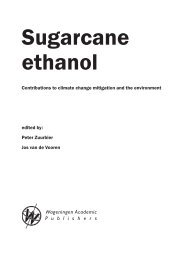Production and use of fuel ethanol in Brazil - BAFF
Production and use of fuel ethanol in Brazil - BAFF
Production and use of fuel ethanol in Brazil - BAFF
Create successful ePaper yourself
Turn your PDF publications into a flip-book with our unique Google optimized e-Paper software.
62<br />
C2.4.<br />
How are employment levels expected to evolve<br />
<strong>in</strong> the face <strong>of</strong> <strong>in</strong>creas<strong>in</strong>g mechanization <strong>and</strong><br />
automation?<br />
The Centro de Tecnologia Canavieira, or Sugar-Cane Technology Center, among<br />
others, has assessed the impact <strong>of</strong> sugar-cane harvest<strong>in</strong>g without burn<strong>in</strong>g on labor.<br />
For a hypothetical future situation with a mechanization level <strong>of</strong> 100 percent <strong>in</strong> the<br />
State <strong>of</strong> São Paulo <strong>and</strong> 50 percent <strong>in</strong> the rest <strong>of</strong> the country, there would be 165,000<br />
jobs less than <strong>in</strong> the fully manual harvest<strong>in</strong>g system based on the total number <strong>of</strong><br />
jobs <strong>in</strong> 2000. That process is <strong>in</strong> progress, <strong>and</strong> rapidly <strong>in</strong> São Paulo. Us<strong>in</strong>g the straw<br />
as an energy source could create more jobs <strong>in</strong> the agricultural area if balers are <strong>use</strong>d<br />
(which is not def<strong>in</strong>ed as technology at the moment). Indirect jobs were not <strong>in</strong>cluded<br />
<strong>in</strong> the computation.<br />
A large portion <strong>of</strong> the fall <strong>in</strong> direct agricultural jobs <strong>in</strong> the 1990’s was due to the<br />
implementation <strong>of</strong> mechanical harvest<strong>in</strong>g. Plant<strong>in</strong>g is be<strong>in</strong>g mechanized as well,<br />
although the effect <strong>of</strong> it on jobs is much less significant. That employment leveldecreas<strong>in</strong>g<br />
effect was widely expected as early as 15 years ago, when the limitation<br />
on sugar-cane burn<strong>in</strong>g began to be discussed, along with the result<strong>in</strong>g reduction <strong>of</strong><br />
manual sugar-cane harvest<strong>in</strong>g. The great, ongo<strong>in</strong>g expansion <strong>of</strong> the crop area is now<br />
start<strong>in</strong>g to extend outside the regions covered by exist<strong>in</strong>g plants; that expansion,<br />
most <strong>of</strong> which already us<strong>in</strong>g mechanical technology, is us<strong>in</strong>g local labor <strong>and</strong> keeps<br />
the absolute number <strong>of</strong> jobs <strong>in</strong> the bus<strong>in</strong>ess exp<strong>and</strong><strong>in</strong>g as well.<br />
As <strong>in</strong> the case <strong>of</strong> soybean, there have been improvements <strong>in</strong> jobs (more qualified<br />
workers, such as mach<strong>in</strong>e operators <strong>in</strong> stead <strong>of</strong> sugar-cane reapers) <strong>and</strong> <strong>in</strong>come <strong>in</strong><br />
the bus<strong>in</strong>ess.<br />
C. Sugar-cane <strong>and</strong> <strong>ethanol</strong> production: social impacts












